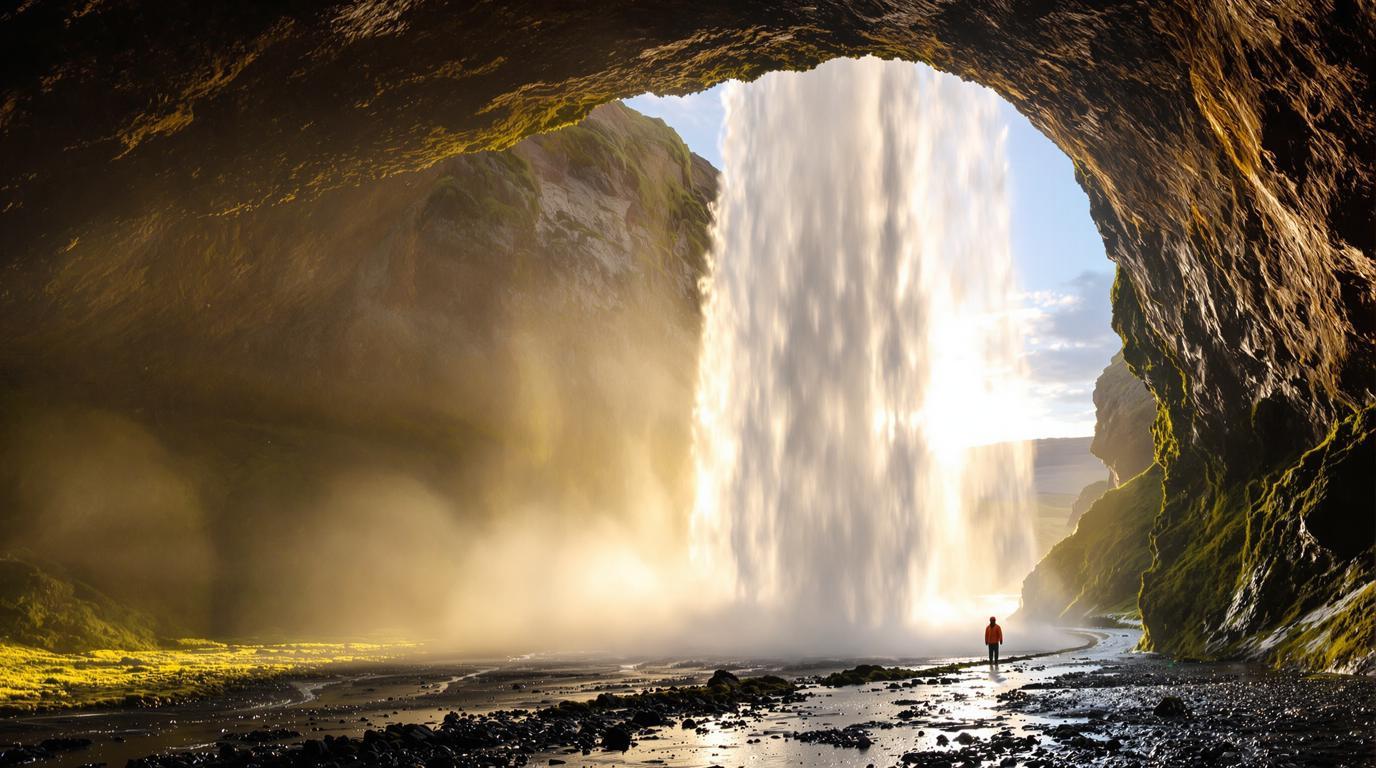Iceland’s Seljalandsfoss waterfall isn’t just another cascade—it’s one of the few places on Earth where you can literally walk behind a thundering wall of water. This 197-foot natural wonder creates an almost mystical experience as sunlight filters through the curtain of water, casting rainbows in the mist that envelops visitors brave enough to make the journey behind the falls.
A waterfall with a backstage pass
What makes Seljalandsfoss truly unique is the natural cave formation that allows visitors to walk a complete 360-degree path around and behind the falls. This rare geological feature creates an experience that feels like stepping into another world—one where the roar of water drowns out all other sounds and fine mist clings to your skin and clothes.
“Standing behind Seljalandsfoss is like being backstage at nature’s greatest performance. The curtain of water frames the landscape perfectly, creating a view you simply can’t experience anywhere else in Iceland,” says Björn Ólafsson, a local guide who has been leading tours to the falls for over a decade.
The science behind the spectacle
Fed by the melting waters of the notorious Eyjafjallajökull glacier volcano (yes, the one that disrupted European air travel in 2010), Seljalandsfoss plunges dramatically over what was once part of Iceland’s coastline. Over centuries, the sea has receded, leaving behind towering cliffs that now serve as the backdrop for this natural marvel.
When to visit for the ultimate experience
While accessible year-round, summer offers the safest conditions for the behind-the-falls walk. Visit during sunset (around 10-11 PM in summer) when the low-angled sunlight creates a golden glow through the cascading water. Winter transforms the falls into a crystalline wonderland, though the path behind is often closed due to ice.
The hidden neighbor worth discovering
Just a five-minute walk from Seljalandsfoss lies its secretive sibling—Gljúfrabúi. This “canyon dweller” waterfall remains hidden within a cliff crevice, requiring visitors to wade through a shallow stream to witness its secluded splendor. It’s reminiscent of the hidden coastal treasures of Kenya, where natural wonders often lurk just beyond the obvious attractions.
Practical tips for your visit
Expect to get wet—very wet. Waterproof clothing, sturdy footwear, and protection for cameras are absolute necessities. The parking lot charges 1000 ISK (about $7), which helps maintain facilities. For a less crowded experience, arrive before 9 AM or after 6 PM, when most tour buses have departed.
The photographer’s dream
Few natural settings offer the photographic potential of Seljalandsfoss. The cave behind creates a natural frame, while the interplay of light and water provides endless creative opportunities. Like the mysterious watchtowers of Georgia, this Icelandic marvel seems designed specifically to capture the imagination.
“I’ve photographed landscapes across six continents, but the light at Seljalandsfoss during summer evenings is utterly magical—it’s as if the water is carrying the sunset directly to you,” shares Emma Thordarson, an Icelandic landscape photographer.
Beyond the falls: Iceland’s south coast
Seljalandsfoss serves as the perfect starting point for exploring Iceland’s dramatic south coast. Within a 30-minute drive lies Skógafoss waterfall, the black sand beaches of Vík, and landscapes that seem as otherworldly as Africa’s salt crystal lakes.
The diversity of plant life around the falls, while not as extensive as Cape Town’s Table Mountain, showcases Iceland’s resilient moss and lichen species that thrive in this mist-laden environment.
A medieval connection
The area surrounding Seljalandsfoss contains remnants of early Icelandic settlements dating back to the 9th century. Much like medieval Catalan towns with their hidden histories, these sites offer glimpses into the harsh lives of Viking-age inhabitants who settled this unforgiving but beautiful landscape.
Standing behind Seljalandsfoss as water thunders down before you and daylight filters through the liquid curtain, you’ll understand why Icelanders consider this place magical. It’s not just a waterfall—it’s a portal to experiencing nature from an entirely new perspective, one that will leave you breathless and wondering how soon you can return.
